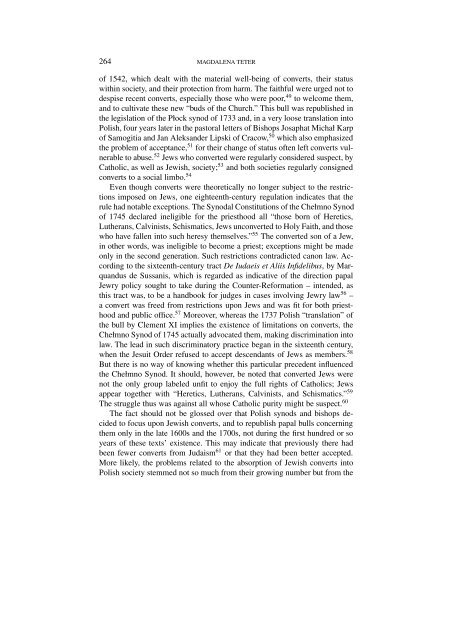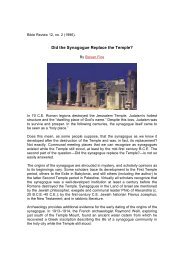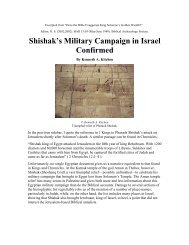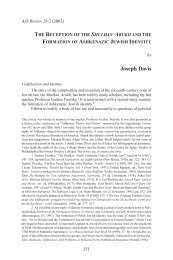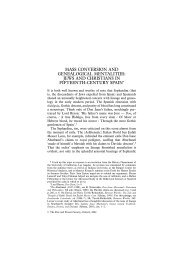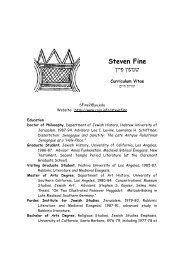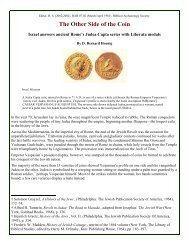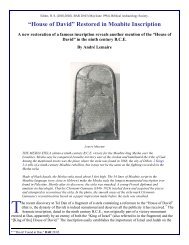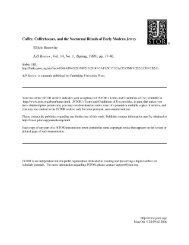Jewish conversions to Catholicism in the Polish-Lithuanian ...
Jewish conversions to Catholicism in the Polish-Lithuanian ...
Jewish conversions to Catholicism in the Polish-Lithuanian ...
You also want an ePaper? Increase the reach of your titles
YUMPU automatically turns print PDFs into web optimized ePapers that Google loves.
264 MAGDALENA TETER<br />
of 1542, which dealt with <strong>the</strong> material well-be<strong>in</strong>g of converts, <strong>the</strong>ir status<br />
with<strong>in</strong> society, and <strong>the</strong>ir protection from harm. The faithful were urged not <strong>to</strong><br />
despise recent converts, especially those who were poor, 49 <strong>to</strong> welcome <strong>the</strong>m,<br />
and <strong>to</strong> cultivate <strong>the</strong>se new “buds of <strong>the</strong> Church.” This bull was republished <strong>in</strong><br />
<strong>the</strong> legislation of <strong>the</strong> Płock synod of 1733 and, <strong>in</strong> a very loose translation <strong>in</strong><strong>to</strong><br />
<strong>Polish</strong>, four years later <strong>in</strong> <strong>the</strong> pas<strong>to</strong>ral letters of Bishops Josaphat Michał Karp<br />
of Samogitia and Jan Aleksander Lipski of Cracow, 50 which also emphasized<br />
<strong>the</strong> problem of acceptance, 51 for <strong>the</strong>ir change of status often left converts vulnerable<br />
<strong>to</strong> abuse. 52 Jews who converted were regularly considered suspect, by<br />
Catholic, as well as <strong>Jewish</strong>, society; 53 and both societies regularly consigned<br />
converts <strong>to</strong> a social limbo. 54<br />
Even though converts were <strong>the</strong>oretically no longer subject <strong>to</strong> <strong>the</strong> restrictions<br />
imposed on Jews, one eighteenth-century regulation <strong>in</strong>dicates that <strong>the</strong><br />
rule had notable exceptions. The Synodal Constitutions of <strong>the</strong> Chełmno Synod<br />
of 1745 declared <strong>in</strong>eligible for <strong>the</strong> priesthood all “those born of Heretics,<br />
Lu<strong>the</strong>rans, Calv<strong>in</strong>ists, Schismatics, Jews unconverted <strong>to</strong> Holy Faith, and those<br />
who have fallen <strong>in</strong><strong>to</strong> such heresy <strong>the</strong>mselves.” 55 The converted son of a Jew,<br />
<strong>in</strong> o<strong>the</strong>r words, was <strong>in</strong>eligible <strong>to</strong> become a priest; exceptions might be made<br />
only <strong>in</strong> <strong>the</strong> second generation. Such restrictions contradicted canon law. Accord<strong>in</strong>g<br />
<strong>to</strong> <strong>the</strong> sixteenth-century tract De Iudaeis et Aliis Infidelibus, byMarquandus<br />
de Sussanis, which is regarded as <strong>in</strong>dicative of <strong>the</strong> direction papal<br />
Jewry policy sought <strong>to</strong> take dur<strong>in</strong>g <strong>the</strong> Counter-Reformation – <strong>in</strong>tended, as<br />
this tract was, <strong>to</strong> be a handbook for judges <strong>in</strong> cases <strong>in</strong>volv<strong>in</strong>g Jewry law 56 –<br />
a convert was freed from restrictions upon Jews and was fit for both priesthood<br />
and public office. 57 Moreover, whereas <strong>the</strong> 1737 <strong>Polish</strong> “translation” of<br />
<strong>the</strong> bull by Clement XI implies <strong>the</strong> existence of limitations on converts, <strong>the</strong><br />
Chełmno Synod of 1745 actually advocated <strong>the</strong>m, mak<strong>in</strong>g discrim<strong>in</strong>ation <strong>in</strong><strong>to</strong><br />
law. The lead <strong>in</strong> such discrim<strong>in</strong>a<strong>to</strong>ry practice began <strong>in</strong> <strong>the</strong> sixteenth century,<br />
when <strong>the</strong> Jesuit Order refused <strong>to</strong> accept descendants of Jews as members. 58<br />
But <strong>the</strong>re is no way of know<strong>in</strong>g whe<strong>the</strong>r this particular precedent <strong>in</strong>fluenced<br />
<strong>the</strong> Chełmno Synod. It should, however, be noted that converted Jews were<br />
not <strong>the</strong> only group labeled unfit <strong>to</strong> enjoy <strong>the</strong> full rights of Catholics; Jews<br />
appear <strong>to</strong>ge<strong>the</strong>r with “Heretics, Lu<strong>the</strong>rans, Calv<strong>in</strong>ists, and Schismatics.” 59<br />
The struggle thus was aga<strong>in</strong>st all whose Catholic purity might be suspect. 60<br />
The fact should not be glossed over that <strong>Polish</strong> synods and bishops decided<br />
<strong>to</strong> focus upon <strong>Jewish</strong> converts, and <strong>to</strong> republish papal bulls concern<strong>in</strong>g<br />
<strong>the</strong>m only <strong>in</strong> <strong>the</strong> late 1600s and <strong>the</strong> 1700s, not dur<strong>in</strong>g <strong>the</strong> first hundred or so<br />
years of <strong>the</strong>se texts’ existence. This may <strong>in</strong>dicate that previously <strong>the</strong>re had<br />
been fewer converts from Judaism 61 or that <strong>the</strong>y had been better accepted.<br />
More likely, <strong>the</strong> problems related <strong>to</strong> <strong>the</strong> absorption of <strong>Jewish</strong> converts <strong>in</strong><strong>to</strong><br />
<strong>Polish</strong> society stemmed not so much from <strong>the</strong>ir grow<strong>in</strong>g number but from <strong>the</strong>


